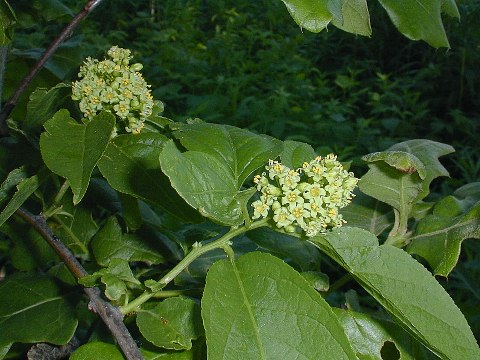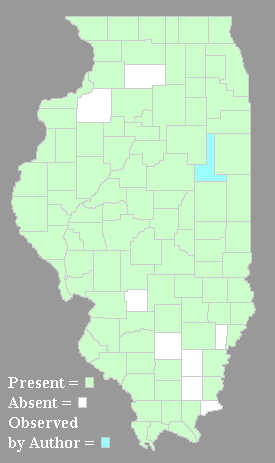Description: This perennial plant is a woody vine up to 30' long that branches occasionally. It often climbs fences and adjacent vegetation by its twining stems, otherwise it sprawls across the ground. Young stems are green and hairless, but they eventually become brown and woody. The alternate leaves are up to 4" long and 2" across (excluding their petioles, which are up to 1" long). They are ovate, finely serrated, and hairless; each leaf tapers gradually to a point at its tip.

Occasionally, short side branches are produced that individually terminate in a panicle of flowers up to 6" long. Each flower is about ¼" across, consisting of 5 light green petals, 5 green sepals, 5 stamens with yellow anthers, and a slender style. The petals are longer than the sepals, and spread outward from the center of the flower. Each petal has a margin that is often jagged or undulate, rather than smooth. The blooming period occurs from late spring to early summer and lasts about 2 weeks. Each flower is replaced by a seed capsule about 1/3" (8 mm.) in length. Upon ripening, the exterior of this capsule becomes orange and splits open into 3 parts, revealing a red aril that covers the seeds (an aril is the fleshy covering that resembles a berry). Each of these capsules contains several large seeds. The root system consists of a woody taproot. This vine spreads by reseeding itself.
Cultivation: This woody vine adapts to a wide range of conditions, including full sun to light shade and moist to dry soil that can contain rich loam, sand, or rocky material. It is usually found in partially shaded conditions.
Range & Habitat: The native American Bittersweet occurs occasionally in most counties of Illinois. It is less common than formerly because of overcollection of the fruiting branches, which were used for decorative purposes during the holidays. Habitats include rocky upland woodlands, sandy woodlands, typical savannas and sandy savannas, thickets, partially shaded banks along rivers, woodland edges along roadsides, limestone glades, fence rows, and sand dunes along Lake Michigan that are beginning to revegetate. Disturbance from fire and other causes are beneficial in wooded areas if they reduce dense shade from the overhead canopy.
during the holidays. Habitats include rocky upland woodlands, sandy woodlands, typical savannas and sandy savannas, thickets, partially shaded banks along rivers, woodland edges along roadsides, limestone glades, fence rows, and sand dunes along Lake Michigan that are beginning to revegetate. Disturbance from fire and other causes are beneficial in wooded areas if they reduce dense shade from the overhead canopy.
Faunal Associations: The nectar and pollen of the flowers attract various bees, including honeybees, little carpenter bees (Celastrina), mason bees (Hoplitis), plasterer bees (Colletes), Halictid bees, and Andrenid bees. The wasp, Euodynerus foraminatus, has been found on the flowers, where it probably sucks nectar (Robertson, 1929; Wilhelm & Rericha, 2017). Other insects feed destructively on this vine. This include the wood-boring larvae of a Buprestid beetle, Chrysobothris azurea, the leaf-mining larvae of a leaf beetle, Sumitrosis rosea, several aphids (Aphis), miscellaneous scale insects, the larvae of two Geometer moths, Eutrapela clemataria (Curve-toothed Geometer) and Pleuroprucha insularia (Common Tan Wave), and the larvae of an Ermine moth, Zelleria celastrusella, which form webs around the terminal leaves of this woody vine (MacRae, 1991; Eiseman, 2016; Hottes & Frison, 1931; ScaleNet, accessed 2014; Natural History Museum, accessed 2010; Covell, 1984/2005; Marshall, 2006; Microleps, accessed 2010). The showy fruits of American Bittersweet are eaten by several kinds of birds; this includes the Bobwhite Quail, Ruffed Grouse, Wild Turkey, Northern Cardinal, Cedar Waxwing, American Robin, Eastern Bluebird, and other birds (see Bird Table). The Fox Squirrel also reportedly feeds on the fruits (see DeGraaf, 2002; Martin et al., 1951/1961; Beal, 1915).
Photographic Location: An oak savanna at the Prospect Cemetery Prairie in Ford County, Illinois.
Comments: The most distinctive characteristic of this woody vine are the orange-red seed capsules; they are quite decorative and attractive. The flowers, as revealed in the photograph above, are not very showy because of their green color. Another species in this genus, Celastrus orbiculatus (Oriental Bittersweet), is less often encountered in Illinois. It was introduced from East Asia as an ornamental vine and has naturalized in a few wooded areas of the state. Because Oriental Bittersweet is a robust woody vine up to 60' long, there is some concern that it may become an invasive species. This has already occurred in some of the NE states. American Bittersweet differs from Oriental Bittersweet by the shape of its leaves, margins of its flower petals, and type of inflorescence. Specifically, American Bittersweet has ovate leaves with gradually tapering tips, flower petals with undulate or jagged margins, and short side branches with terminal panicles of flowers. Oriental Bittersweet, on the other hand, has ovate-orbicular leaves with short broad tips, flower petals with smooth margins, and non-terminal panicles of flowers that develop from the axils of the alternate leaves. Furthermore, the flower petals of Oriental Bittersweet are usually more narrow than those of American Bittersweet.